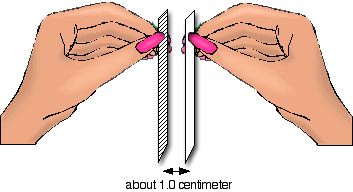
Experimenting with Electrostatic charge.
Materials: 2 white vinyl strips, 2 clear acetate strips, 2 swatches of black wool cloth, 2 swatches of tan cotton cloth, one swatch silk cloth, one glass test tube.
Perform each of the experiments described below. Each student turns in a paper with answers to all questions ( “ q: “ )
1. Briskly rub the clear acetate strip with the cotton cloth. This will place a POSITIVE charge on the strip. Do not set the strip down, hold it by it’s edges
2. Have a lab partner rub the vinyl strip with the wool cloth. Hold the two pieces close to each other (about 1 cm apart) by the edges as shown.

q: is there any sign of electrostatic force of attraction or repulsion?
q. what charge do you think is on the vinyl strip?
3. Charge two acetate strips as in part 1 above and hold them close as shown.
q: explain any electrostatic forces you observe.
4. Charge two vinyl strips as in part 2 above and hold them close as shown.
q: explain any electrostatic forces you observe.